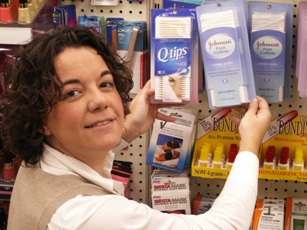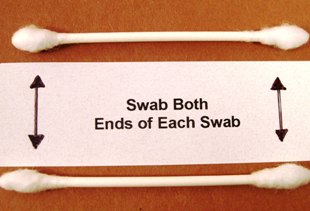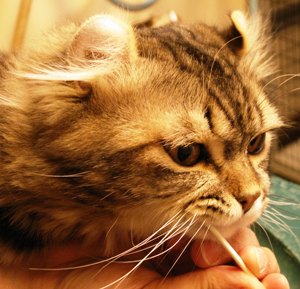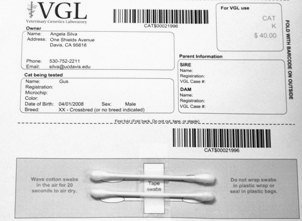Quick Summary
Click here for Price and Turnaround Time
Phenotype: The coat color called "russet" in Burmese cats develops with age and is characterized by progressive amounts of red pigment on the head and dorsal surfaces.
Mode of Inheritance: Autosomal recessive
Alleles: N = Normal or non-russet, R = Russet
Breeds appropriate for testing: Burmese
Explanation of Results:
- Cats with N/N genotype will not have the russet coat color and cannot transmit this Burmese russet variant to their offspring.
- Cats with N/R genotype will not have the russet coat color, but are carriers. They will transmit this Burmese russet variant to 50% of their offspring. Matings between two carriers are predicted to produce 25% russet-coated kittens.
- Cats with R/R genotype will show the russet color when mature, and they will transmit this Burmese russet variant to all of their offspring.
Sample Collection:
Cat DNA tests are carried out using cells collected from your cat's cheeks and gums using household cotton swabs.
The cat DNA submission form with instructions, pricing, and a place to tape the cotton swabs can be printed from your home computer after signing up for a MyVGL account and placing an order. Test kits are not mailed.
Step-By-Step Instructions:
1.
 Purchase regular household cotton swabs for cat DNA collection (the cotton swabs can be purchased at a pharmacy or drug store)
Purchase regular household cotton swabs for cat DNA collection (the cotton swabs can be purchased at a pharmacy or drug store)
2.
 Use both ends of the two cotton swabs for a total of four swabs.
Use both ends of the two cotton swabs for a total of four swabs.
3.
 Collect the DNA sample by swabbing the cheek and gums of the cat.
Collect the DNA sample by swabbing the cheek and gums of the cat.
4.
 After swabbing the cheek and gums, tape the cotton swabs to the bar-coded submission form printed from your MyVGL account.
After swabbing the cheek and gums, tape the cotton swabs to the bar-coded submission form printed from your MyVGL account.
A new coat color termed “Russet” has been identified in Burmese cats with Australian and New Zealand lineages. The russet phenotype develops with age. Young russet kittens have color and markings largely identical to tabby kittens of the same age and base color, regardless of whether the kitten is agouti (A-) or non-agouti (aa) in genotype. However, the tail-tip, genital area, and fur around the paw pads are pale in russets rather than marked with dense eumelanin (brown/black pigment) as in tabbies. The nose leather is entirely pink rather than outlined in eumelanin, and the paw pads are pale, later losing all melanin to become bright pink. As the kitten grows, the solid eumelanin areas are progressively overlain with presumably phaeomelanin (red pigment), starting at the head, which usually turns entirely red. On the dorsal surfaces, broad tipping of the fur with phaeomelanin develops gradually. There is also some reduction in density of melanin in the bottom half of the hair nearest the skin. The mature cat is superficially reddish all over, but with the eumelanin pigment in the dorsal undercoat visible to an extent that varies between individuals.
Russet is an autosomal recessive trait which means that two copies of the russet allele are needed to produce the phenotype. The mutation causing the russet coat color is in the gene MC1R and is a deletion (c.439_441del) resulting in an altered form of the gene. The russet mutation is fairly uncommon as it only occurs in certain Burmese cat lines.
Testing for this Burmese russet coat color variant can assist breeders in identifying Burmese russet colored cats and carriers of this variant. Cats of questionable coloration, including those thought to be dilute, should test for russet prior to considering the dilute modifier.



